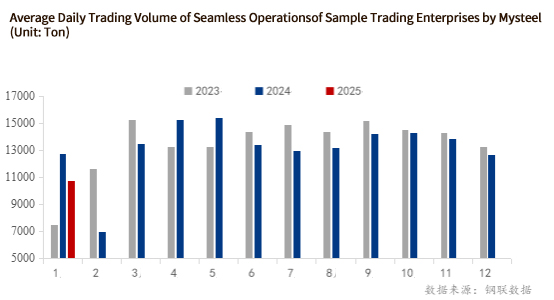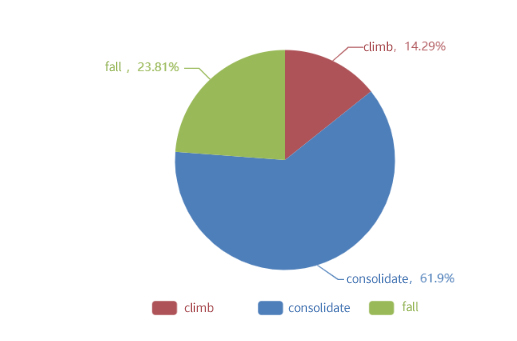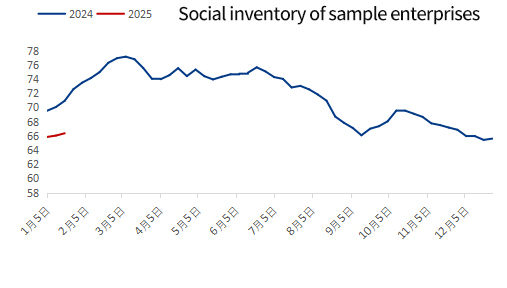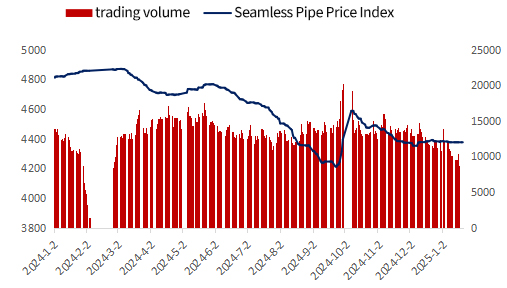As the second week of January unfolded, domestic seamless pipe transactions noticeably decreased, accompanied by a slight drop in average prices. The market experienced a simultaneous decline in both volume and price. By January 17, the Mysteel Seamless Pipe Absolute Price Index stood at 4374.79, down 7.42 points from the beginning of the month. The market has now entered a stable pre-holiday phase. Historically, pre-holiday prices tend to show a steady-to-slightly-increasing trend, while reduced demand during the offseason is typical. However, the unusual pre-holiday price drops this year reflect heightened risk aversion. What is driving this trend, and what can we expect after the holiday?
Recent data shows that daily transactions in January averaged 10,838 tons, down 4.4% year-on-year. The earlier-than-usual Lunar New Year holiday has impacted January's demand. Adjusting for the same lunar calendar period, last year's pre-holiday daily transactions were approximately 11,183 tons, representing a 3.09% actual decline. Even after accounting for holiday factors, pre-holiday demand remains weaker than last year.

Unclear Market Sentiment and Lower Stockpiling
According to the latest surveys, downstream steel-consuming enterprises are cautious about price trends. Most respondents expect short-term price fluctuations, while only 14.29% anticipate a price increase. Consequently, pre-holiday stockpiling by end-users has significantly decreased, with many postponing procurement plans to minimize risks and costs.

Trade-Side Inventory Reductions
End-user hesitation to stockpile has affected traders, who have proactively reduced inventory due to slim winter storage profits. Mysteel's latest data (as of January 16) shows a national social inventory of 663,600 tons, down 45,800 tons year-on-year. Winter stockpiling enthusiasm has waned, with many traders skipping winter storage altogether.
Recent years have shown that demand is becoming less elastic to price changes. In 2024, for instance, demand did not significantly respond to price fluctuations during peak demand periods (March–May and August–October). This trend indicates a reduction in speculative demand, with overall demand becoming more rigid.

Despite weaker market sentiment, demand exhibits some resilience:
Total seamless pipe production for 2024 was lower than in 2023, with higher production concentration among larger manufacturers.
Apparent seamless pipe consumption in 2024 reached approximately 24.75 million tons, showing no significant decline compared to last year.
In 2025, supply and demand are expected to remain tightly balanced. While pre-holiday procurement has decreased, postponed purchases and post-holiday rigid demand could drive recovery.

By January 14, construction project funding availability reached 66.24%. Non-residential projects had a funding rate of 69%, while residential projects stood at 52.31%. Improved funding levels and year-end payments are expected to boost liquidity for downstream enterprises, potentially revitalizing demand post-holiday.
Pre-holiday inventory levels for both traders and manufacturers are noticeably lower than last year. As of mid-January, the total factory inventory of major seamless pipe mills was 625,000 tons, down 45,000 tons year-on-year. With mill operating rates at 45% and output set to rise post-holiday, traders are likely to restock, especially if market sentiment improves.
While pre-holiday demand has weakened, rigid purchasing needs persist. Coupled with limited supply, post-holiday seamless pipe prices may see upward movement, especially if demand materializes alongside positive market signals.